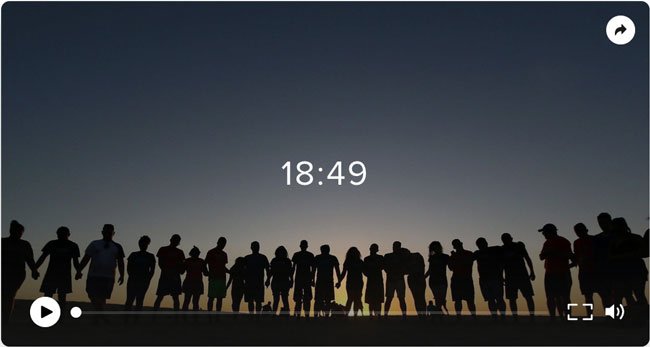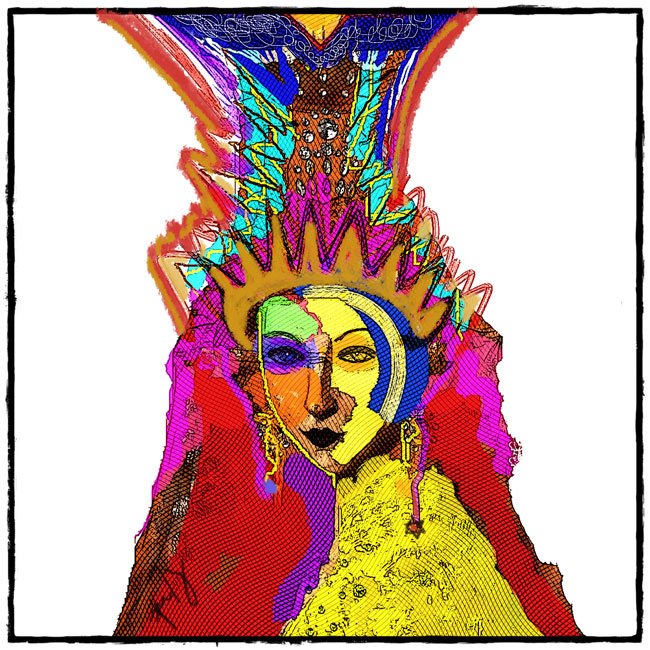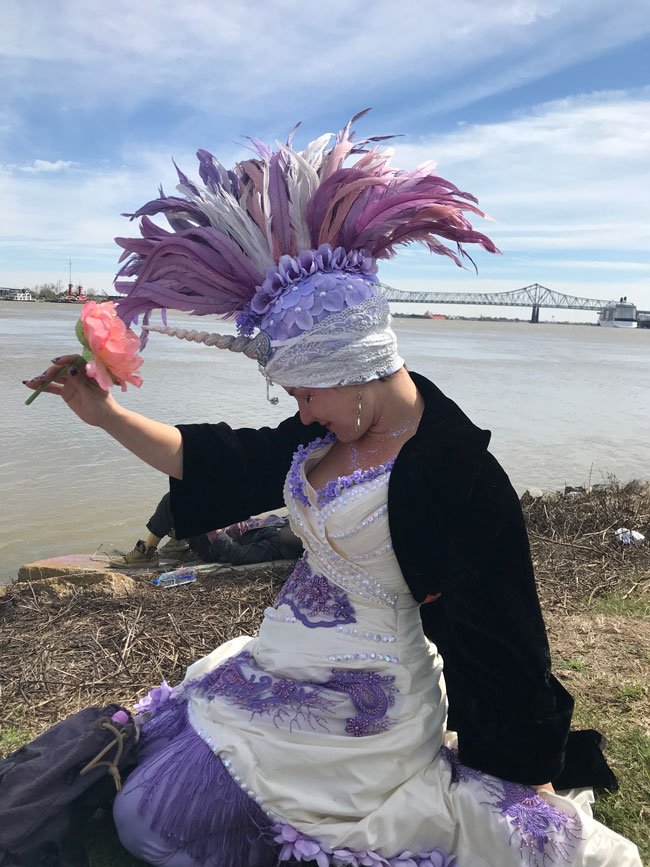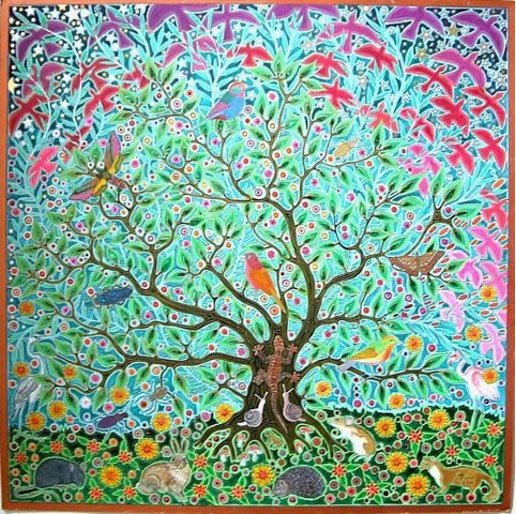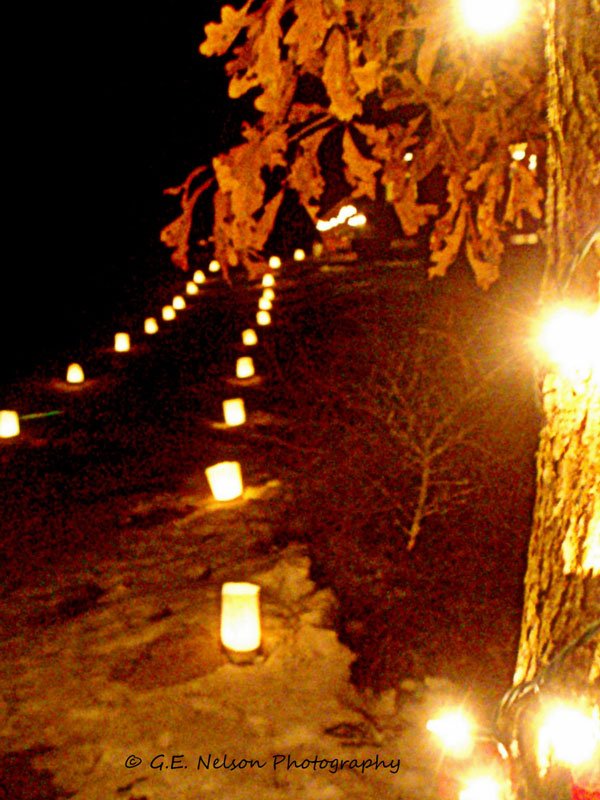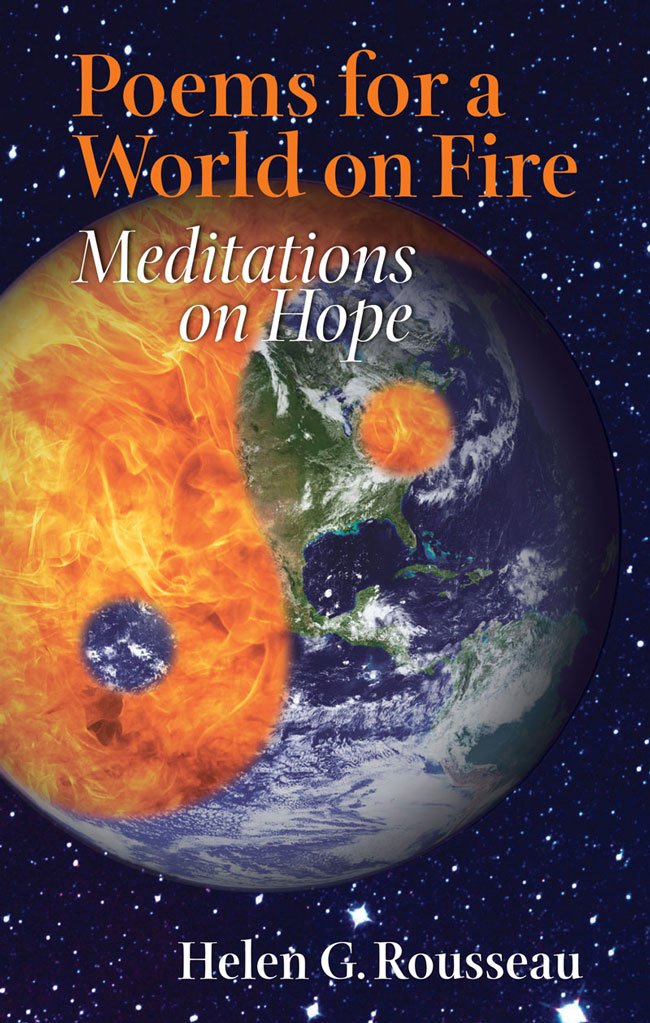Your Custom Text Here
Waxing Moon, Melting Snow

By Lisa Steele-Maley,
Last night, as I stood under the stars, the waxing crescent moon caught my eye. Over the next ten days, its light will steadily grow until it is high in the sky, illuminating the midnight field as if it were twilight. I imagine the snow and ice will continue their slow and steady melt during that same time.
The signs of spring are clear. The eaves of the roof are dripping steadily. In the morning, the smell of the skunk who passed by in the night lingers and the early birds persistently declare their presence. The critters are stirring. It is no wonder that I am stirring too.
I am a lover of light. My body is fully aware that we are nearing the spring equinox. The current cycle of the moon amplifies that recognition. Longer, brighter, warmer days infuse my body with energy, my mind with creativity, and my heart with gratitude. Bright moonlit nights encourage me to linger on my evening walk.
While the light is growing, the darkness is receding. There is a gentle gestation that can only happen under the shroud of darkness and the deep, contemplative hibernation of winter. It is hard to simply let go of the safety and comfort of the dark cave that has held and nurtured me through the previous long months. But when I honor it and give thanks for it, I can hold both the shrinking, dark coolness and the expanding, bright warmth with equal appreciation.
I am reminded to remain present. There is abundant beauty, love, and learning in each moment. I feel them deeply when I attend to the reality that each moment contains the delicate balance between light and dark, expansion and contraction. The present moment is the only time and place to experience the fullness of life’s offering.
An excerpt from Arriving Here: Reflections from the Hearth and Trail, now available at your local bookstore or online. Learn more, read reviews, and order. Register for the book launch March 10, 17, 24.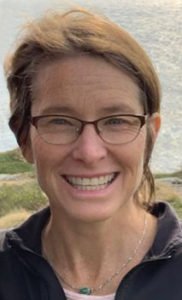 In her actions and her words, Lisa Steele-Maley weaves together her roles as mother, daughter, wife, writer, and educator. Ordained by the Chaplaincy Institute of Maine (ChIME) in 2019, Lisa nurtures the fierce and tender connections between self, spirit, land, and community. Her writing reflects a strong connection to the affirming rhythms of the natural world and keen attention to the details of daily living and relationships.
In her actions and her words, Lisa Steele-Maley weaves together her roles as mother, daughter, wife, writer, and educator. Ordained by the Chaplaincy Institute of Maine (ChIME) in 2019, Lisa nurtures the fierce and tender connections between self, spirit, land, and community. Her writing reflects a strong connection to the affirming rhythms of the natural world and keen attention to the details of daily living and relationships.
Lisa lives in an aging farmhouse on the coast of Maine with her husband, two teenage sons, and a handful of animals. Her newest book, Arriving Here: Reflections from the Heart and Trail, was published in December 2020. Learn more at lisa.steelemaley.io.
Arriving Here cover photograph by Lisa Steele-Maley, book cover design by Lindy Gifford.
Covid-19: Healing The Grief Of Isolation
By Rev. Jacob Watson,
Fulfilled by remembering these three truths: we connect with our peoples, we are at home with our intimate self and finally we are one with the Divine. We know in this new precious affirmation that we are not ever isolated, indeed, never have been isolated, and finally, never will be isolated: we are whole with our fellow human beings, near and far, we are one with ourselves, here and now, and we are Divine, right now.
Click to listen to the InsightTimer meditation: Covid 19: Healing the Grief of Isolation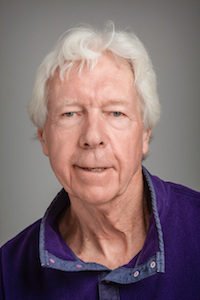 Rev. Jacob Watson, D.Min. is the author of We’re Gainin’: Collins Brook, A Maine Free School—A Memoir, which he wrote to celebrate the 50th anniversary of the school’s founding in 1969. Jacob founded Collins Brook School and the Chaplaincy Institute of Maine. He is teaching a pilot interfaith chaplaincy program to students in Brazil and Guatemala. His Morning Blessing Gift meditations and Mini-Satsangs are available as audio recordings on the free meditation app Insight Timer. He may be reached through his web site revjacobwatson.com.
Rev. Jacob Watson, D.Min. is the author of We’re Gainin’: Collins Brook, A Maine Free School—A Memoir, which he wrote to celebrate the 50th anniversary of the school’s founding in 1969. Jacob founded Collins Brook School and the Chaplaincy Institute of Maine. He is teaching a pilot interfaith chaplaincy program to students in Brazil and Guatemala. His Morning Blessing Gift meditations and Mini-Satsangs are available as audio recordings on the free meditation app Insight Timer. He may be reached through his web site revjacobwatson.com.
Dissolving Boundaries, Achieving Justice: The Jewish Festival of Purim
By Joyce Zonana,
Like Mardi Gras, the Jewish holiday of Purim, observed this year from February 25th through 26th, is a festival marked by masking and drunkenness, a feast in which the world as we know it is turned upside down. The story behind Purim is told in The Book of Esther, known as the Megillah. Each year, this tale set in ancient Persia is read aloud, twice, in synagogues on Purim.
In The Book of Esther, Haman is the arch-enemy of the Jews, condemning them all to death because one of them—Mordecai—refuses to bow down. Mordecai’s young, orphaned cousin Esther is married to the tyrannical king of Persia, Ahaseurus, an autocrat who enjoys parading his wealth and power.
It is Esther who single-handedly saves the Jews from extermination. Chosen by Ahaseurus after he impulsively banished Vashti, his first wife, for refusing to obey him, Esther has concealed her Jewish identity. (These men had a thing about obedience.) But when the moment arises—Esther risks all to petition the king, announcing,
“And if I perish, I perish.”
Esther’s words reverberate through the centuries. Her willingness to sacrifice herself sets a powerful example for others. In 1836, Angelina Grimke, the noted white abolitionist, addressed an “Appeal to Christian Women of the South”: “Is there no Esther among you,” she asked, “who will plead for the poor devoted slave? … If there were but one Esther at the South, she might save her country from ruin; but let the Christian women there arise … and that salvation is certain.”
Other women writers and activists have found inspiration in The Book of Esther, including Elizabeth Cady Stanton who, in her 1898 Woman’s Bible called it “this first stand for women’s rights.” In 1871, Frances Ellen Watkins Harper, a Black abolitionist and suffragist, published a stirring poem celebrating Vashti’s refusal to bow down: “Strong in her earnest womanhood / she calmly met her fate.”
One striking feature of The Book of Esther is that it never mentions “God.” Both the condemnation and the salvation of the Jews come about through human action, not divine intervention. So Purim invites us to consider what each of us can do in response to the injustices we face. As Mordecai tells Esther when she at first resists his plea to intervene with Ahaseurus, “who knoweth whether thou art come to the kingdom for such a time as this?”
An ancient rabbinic commentator on the Megillah observed, “A person is obligated to drink on Purim until he does not know the difference between ‘cursed be Haman’ and ‘blessed be Mordechai.’” Much ink has been spilled seeking to understand that dictum: but for me, it means, simply, that Purim is a time when the boundaries we think govern our world are dissolved. The weak stand up to the strong, the rich bow down to the poor, the disenfranchised vote, tyrants are deposed. Just as at Mardi Gras, the masks we don reveal our essential oneness. The divine shines through.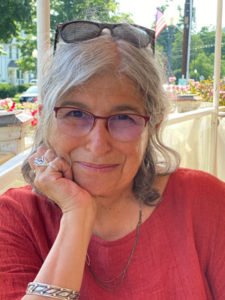 Joyce Zonana, a regular contributor to the online journal Feminism and Religion, is a writer and literary translator. Her most recent translation is Tobie Nathan’s novel, A Land Like You, a celebration of Jewish life in Egypt in the first half of the twentieth century. She is also the author of a memoir, Dream Homes: From Cairo to Katrina, an Exile’s Journey.
Joyce Zonana, a regular contributor to the online journal Feminism and Religion, is a writer and literary translator. Her most recent translation is Tobie Nathan’s novel, A Land Like You, a celebration of Jewish life in Egypt in the first half of the twentieth century. She is also the author of a memoir, Dream Homes: From Cairo to Katrina, an Exile’s Journey.
“The Divine Shines Through,” Reprinted by permission of the artist, Deborah Saltz Amerling.
Beneath the Mask
By Sivani Katie Gelfand,
Mardi Gras—Fat Tuesday—is celebrated in many western cultures as an opportunity for excess and celebration before entering the more somber period of Lent. Other than my years in college, I’ve lived in New Orleans all my life and the energy of Mardi Gras is steeped in my soul.
To most outsiders, the costumes many locals assume for Mardi Gras are just part of the festivities. Tourists don’t understand that for many New Orleanians, the choice of costume can be a highly personal and transformative experience.
Two years ago on Mardi Gras Day, I was a unicorn. Anyone can just be a unicorn because they think unicorns are cool. But the why behind my costume is what made it truly special. Fourteen months before I wore this costume, I went through a painful and drawn-out divorce from my partner of 13 years. One lingering fragment to closing this chapter that still haunted me, was my wedding dress. This beautiful, expensive gown, that I wore on what was supposed to be the happiest day of my life, was now soured by the memories of the breakup. I had to do something with the dress, either burn it…or transform it. And I had to shift the energy around myself, from being a broken and love-starved divorcée, into an independent, confident woman who loved herself rather than seeking love from another. I knew that transforming this dress, with intention was the solution. But what could I be in a white dress?
Then I started noticing unicorns everywhere. Unicorns are white, I thought. So I guess I could be a unicorn. Then I remembered one of my favorite childhood movies, The Last Unicorn, the harrowing adventure of a unicorn who journeys to the ends of the earth to find and save her kin and discover her true power. The courage, poise, mystical beauty, purity, and healing abilities of this mythical creature were everything I needed to embody in myself, to heal from my divorce, and move on in my life with grace.
Putting this kind of intention into my costume gave Mardi Gras Day a whole new meaning for me. By donning this costume, I was becoming Unicorn. On the outside to others, I was just a girl in a unicorn costume. But beneath the mask, I was embodying the qualities of this mystical creature and moved through the festivities of the day as Unicorn. I even ran into my ex-husband, sprinkled some fairy dust on him, and trotted on my way. From that day on I felt changed. The qualities I was seeking for myself through the magic of becoming the unicorn seeped into my being and took root. It was a truly transformational costuming experience.
Our fantasies teach us about our deepest desires and the true longings of our heart. Costuming is more than just a game of make-believe. It is an opportunity to try on something that possesses qualities we aspire to and explore the possibility of embodying our dreams. You would be surprised what you discover about yourself, and what sticks with you when the costume comes off. It might just lead you to who you truly are.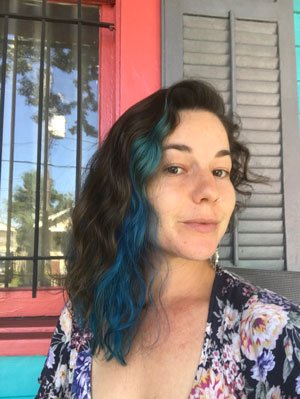 Sivani Katie Gelfand is the Director of Religious Exploration at the First Unitarian Universalist Church of New Orleans, the congregation in which she was raised. Concurrent to this ministry she is also a certified Spiritual Guide and Reiki Master Teacher. Sivani believes healing is the process of strengthening, deepening, and surrendering ourselves in the name of transformation. She is committed to compassionately supporting others along their journey to wholeness by guiding individuals to nurture and trust the deep wisdom of their own hearts. www.sivanistar.com
Sivani Katie Gelfand is the Director of Religious Exploration at the First Unitarian Universalist Church of New Orleans, the congregation in which she was raised. Concurrent to this ministry she is also a certified Spiritual Guide and Reiki Master Teacher. Sivani believes healing is the process of strengthening, deepening, and surrendering ourselves in the name of transformation. She is committed to compassionately supporting others along their journey to wholeness by guiding individuals to nurture and trust the deep wisdom of their own hearts. www.sivanistar.com
The Power of Love
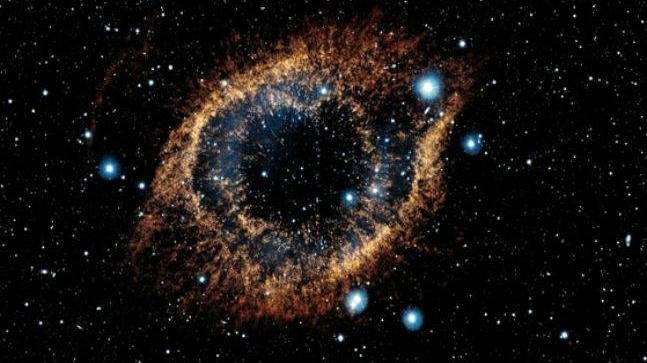
By gkisedtanamoogk,
Reflecting on the conditions of life surrounding us at any one time and throughout history, and in capitulating to our fears from such horrid acts as we have recently witnessed, might give us a sense of depression and pessimism of our Selves in regarding human nature. However, the matter remains the stark contrast between what appears to be true, to what is actually true. Although we may not collectively hold any distinction between what we see and believe and what is actual in existence, yet often escaping our periphery, the Power of Love is absolute. Aside from the contributions and descriptions we place on the value of love, there is much more depth and profundity to what actually is Love. We witness life in every capacity from the microscopic to the depths of the seen Universe; all are created in set patterns. It is this pattern that implicates the esoteric nature of Love. Avatars throughout time brought the simplicity of this force in the universe, and for a time, manifested calm and joy in our being. The end of hatred, violence, greed, and the multitudes of human consequences we define as fear, comes by way of the Will. Simply put, if we choose to intentionally transfer our Selves to the abounding Oneness through Love Absolute, there will be no hate, no violence, no greed. At this moment, we must entrench the re-learning of the power to Love that we held as Little Ones, this being Love Absolute, for the love we now hold as adults. What we hold now as love has a corruption-level mystique that shadows our human footprint and direction; this shadow inhibits the actual love to the capacity for love, noting there is a grave difference. Be certain, the Power of Love is actual, abundant, lives within everything, and if we so choose can be seen, heard, felt everywhere; we are immersed in its Power and Oneness with the Universe. gkisedtanamoogk, is from the Wampanoag Community of Mashpee located on cape cod south of boston, massachusetts, married to Miigam’agan. Together they have three Children and three Grandchildren. He was one of five Commissioners on the Maine Wabanaki State Child Welfare Truth and Reconciliation Commission and taught for 10 years at the University of Maine. He has shared several presentations with the Chaplaincy Institute of Maine. gkisedtanamoogk resides with his Family at Esgenoôpetitj on the Burnt Church Reserve; he would say that Mi’kmaq Homelands are occupied by the province of new brunswick and canada.
gkisedtanamoogk, is from the Wampanoag Community of Mashpee located on cape cod south of boston, massachusetts, married to Miigam’agan. Together they have three Children and three Grandchildren. He was one of five Commissioners on the Maine Wabanaki State Child Welfare Truth and Reconciliation Commission and taught for 10 years at the University of Maine. He has shared several presentations with the Chaplaincy Institute of Maine. gkisedtanamoogk resides with his Family at Esgenoôpetitj on the Burnt Church Reserve; he would say that Mi’kmaq Homelands are occupied by the province of new brunswick and canada.
Nebula photo, Hubble telescope, NASA
Celebrating World Interfaith Harmony Week
By Robert Atkinson,
On this 11th anniversary of World Interfaith Harmony Week, created by a United Nations General Assembly Resolution, following upon their longstanding promotion of interreligious and intercultural dialogue and cooperation, it is more important than ever to acknowledge and put into action the universal moral imperatives of all religions.
This message of interfaith harmony and goodwill, based on love of one’s neighbor, regardless of convictions or beliefs, is expressed in many different ways around the world the week of February 1-7. This year, the Abbey of Hope will partner with Chime and Music Makes Community for a virtual evening of words and song, Thursday, February 4th at 7pm. Join us in a call to action for the realization of “A Global Ethic for the Human Family." For more information and to register.
World Interfaith Harmony Week is a celebration honoring all branches of the sacred tree of spirituality, an understanding at the mystic heart of all the world’s religions. Though they differ slightly from one another, all branches are attached to the same trunk and draw nourishment from the same roots. This is our point of connection to each other and the sacred. A universal ethic unites us in a common vision, a common purpose. Each branch shares a common message of compassion toward all creatures, understanding between all people, and a commitment to serve the common good of all.
The oneness of Divinity is also evident in the image of this ever-growing sacred tree. From the same source, it nourishes the Indigenous branches (all the ancient and modern Native spiritual traditions throughout the world), the Abrahamic branches (the Jewish, Christian, Muslim, and Baha’i traditions), and the Dharmic branches (the Hindu, Zoroastrian, Buddhist, Jain, and Sikh traditions).
This unity of religion is evident in the Pawnee saying, “All religions are but stepping-stones back to God.” All spiritual traditions have similar expressions of this continuous, interconnected nature of spiritual truth, as seen in the Buddha’s view: “I am not the first Buddha, nor shall I be the last. In due time another Buddha will arise in the world… He will reveal to you the same eternal truths,” or in Christ’s vision: “I have many things to tell you… when the spirit of Truth is come, he will guide you unto all truth.”
In the mid-19th century, foreshadowing the current interfaith/interspiritual movement, Baha’u’llah, founder of the Baha’i Faith, proclaimed, “Consort with the followers of all religions in a spirit of friendliness and fellowship,” as this will “promote unity and concord,” because, as he adds, “This is the changeless faith of God, eternal in the past, eternal in the future.”
With such a holistic view of creation, we can see an unbroken line of prophets, spiritual teachers, and visionaries, all inspired by the same spiritual energies that have forever transformed human hearts, shaped and re-shaped institutions, and expanded circles of unity. In our time, we have been guided to a consciousness of the oneness of humanity; we are preparing to realize our collective coming of age. Robert Atkinson, PhD, author, educator, and developmental psychologist, is a 2017 Nautilus Book Award winner for The Story of Our Time: From Duality to Interconnectedness to Oneness. He is also the author or co-editor of eight other books, including Our Moment of Choice: Evolutionary Visions and Hope for the Future (2020), Year of Living Deeply: A Memoir of 1969 (2019), Mystic Journey: Getting to the Heart of Your Soul’s Story (2012), and The Gift of Stories (1995). He is professor emeritus at the University of Southern Maine, founder of One Planet Peace Forum, a member of the Evolutionary Leaders, and deeply committed to assisting the evolution of consciousness toward wholeness and unity. www.robertatkinson.net
Robert Atkinson, PhD, author, educator, and developmental psychologist, is a 2017 Nautilus Book Award winner for The Story of Our Time: From Duality to Interconnectedness to Oneness. He is also the author or co-editor of eight other books, including Our Moment of Choice: Evolutionary Visions and Hope for the Future (2020), Year of Living Deeply: A Memoir of 1969 (2019), Mystic Journey: Getting to the Heart of Your Soul’s Story (2012), and The Gift of Stories (1995). He is professor emeritus at the University of Southern Maine, founder of One Planet Peace Forum, a member of the Evolutionary Leaders, and deeply committed to assisting the evolution of consciousness toward wholeness and unity. www.robertatkinson.net
Tu B’Shevat: The New Year of the Trees and Its Meaning for Me
By Joel A. Mintz,
My religion, Judaism, has numerous holidays. The most widely observed of those are Passover, a joyous celebration of the Jews’ departure from slavery in Egypt, and Yom Kippur, a solemn day of fasting and prayer dedicated to atonement from sins. My favorite holiday is relatively more obscure yet suffused with meaning for me: Tu B’Shevat, the New Year of the Trees.
Tu B’Shevat, a holiday believed to have originated in the Middle East in the 3rd Century A.D. as an agricultural festival, marks the start of a season when the earliest blooming trees in the Land of Israel begin a new fruit bearing cycle. It is celebrated today by the planting of new trees and by the eating of dried fruits and nuts and the drinking of wine.
Tu B’Shevat holds special meaning for me because I am a lifelong lover of nature who—since 1970—has referred to himself an environmentalist. I grew up in an area of Queens, New York that was, in my childhood, semi-rural. Lovely maples, oaks and elms proliferated, and I have fond boyhood memories of collecting fallen leaves, and being taught about the different trees, by my mother’s mother. I was also an enthusiastic member of my elementary school’s garden club. After college and law school, I became an environmental lawyer and then an environmental law professor, practicing with the EPA and several NGOs and training numerous students in the fundamentals of environmental practice.
My love of trees, and other miracles of nature, continues to this day. Trees, with their myriad shapes and sizes, continuously remind me of the greatness of God, the wondrous bounty God has created for us, and the urgent need for us to protect the natural world, for ourselves and generations to come.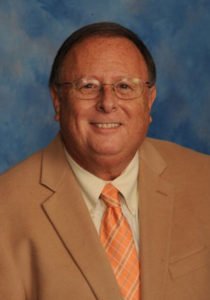 Joel A. Mintz is a retired law professor. He serves on the boards of several environmental organizations, writes books, articles, and op-ed essays on environmental topics, and enjoys regular walks among the palms, palmettos, poincianas and sea grapes of South Florida.
Joel A. Mintz is a retired law professor. He serves on the boards of several environmental organizations, writes books, articles, and op-ed essays on environmental topics, and enjoys regular walks among the palms, palmettos, poincianas and sea grapes of South Florida.
Photo of Autumn in New York by Piotr Bizior
Rising Light
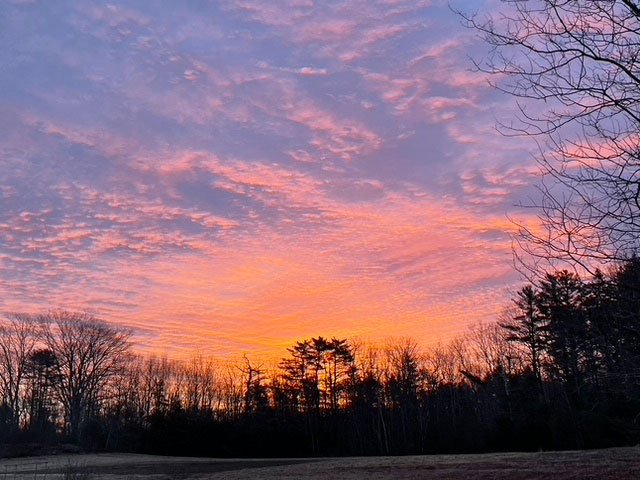
By Lisa Steele-Maley,
January 5, 2021Sunrise, 7:16 am; Sunset, 4:08 pmI notice the lengthening days. This is not a surprise—we passed the solstice several weeks ago. The days had been slowly and steadily getting longer, but in such a subtle way that it didn’t rise to awareness. And then, coming in late from an afternoon walk, I catch pale pink and orange colors of sunset beginning to splash across the sky. The afternoon is newly spacious. The burst of energy brought by the light is doubled by my delight at noticing it as if for the first time.
January 6, 2021Sunrise, 7:16 am; Sunset, 4:09 pmI observe, along with the rest of the world, as the shadowy darkness of American exceptionalism claws its way into the light. The dark underbelly of our nation—with its foundations of racism and violence, greed and corporate rule, individualism and separation—is demanding to be seen and acknowledged as it becomes obsolete, slowly but surely replaced by life-affirming ways of being and doing. Watching news accounts of terrorists entering the US Capitol reminds me of watching the planes fly into the twin towers over and over again during the news reporting on 9/11/2001. Then, as today, the only thought I can hold is, ‘this changes everything.’
I remember Rev. Dr. Martin Luther King Jr. words: “the arc of the moral universe bends toward justice”. I imagine lending words and weight to the arc of the moral universe in whatever small ways I can, grateful that we are in the arc of the celestial year that turns toward the sun. This is more than poetic symmetry. It feels capable of bringing some alignment between human will and universal action.
January 20, 2021Sunrise, 7:09 am; Sunset, 4:27 pmWith tears in my eyes and joy in my heart, I join our country to welcome a new president and vice president. Even shrunken to the 13 IPad perched on the kitchen counter, the Inauguration conveys the grandeur and pomp, gravitas and authenticity of the moment. In the wake of unrest and in the midst of a pandemic, we celebrate a handful of firsts and a call for unity. As President Biden closes his inaugural address, a beam of sunlight splashes across his face. The inaugural poet, Amanda Gorman, closes with words of light, possibility, and responsibility. “The new dawn blooms as we free it. For there is always light if only we’re brave enough to see it. If only we’re brave enough to be it.”
January 21, 2021Sunrise, 7:08 am; 4:28 pmI am up before the sun, casting my light and heat into this new day. In the days and weeks ahead, as the days continue to grow longer and brighter in the northern hemisphere, may we each tend the light within ourselves and each other with tender care and fierce love. May we be brave enough to see it. May we be brave enough to be it. In her actions and her words, Lisa Steele-Maley weaves together her roles as mother, daughter, wife, writer, and educator. Ordained by the Chaplaincy Institute of Maine (ChIME) in 2019, Lisa nurtures the fierce and tender connections between self, spirit, land and community. Her writing reflects a strong connection to the affirming rhythms of the natural world and keen attention to the details of daily living and relationships.
In her actions and her words, Lisa Steele-Maley weaves together her roles as mother, daughter, wife, writer, and educator. Ordained by the Chaplaincy Institute of Maine (ChIME) in 2019, Lisa nurtures the fierce and tender connections between self, spirit, land and community. Her writing reflects a strong connection to the affirming rhythms of the natural world and keen attention to the details of daily living and relationships.
Lisa lives in an aging farmhouse on the coast of Maine with her husband, two teenage sons, and a handful of animals. Her newest book, Arriving Here: Reflections from the Heart and Trail, was published in December 2020. Learn more at lisa.steelemaley.io.
Sunrise by Thatcher Steele-Maley
A Reckoning for the Soul of Turtle Island
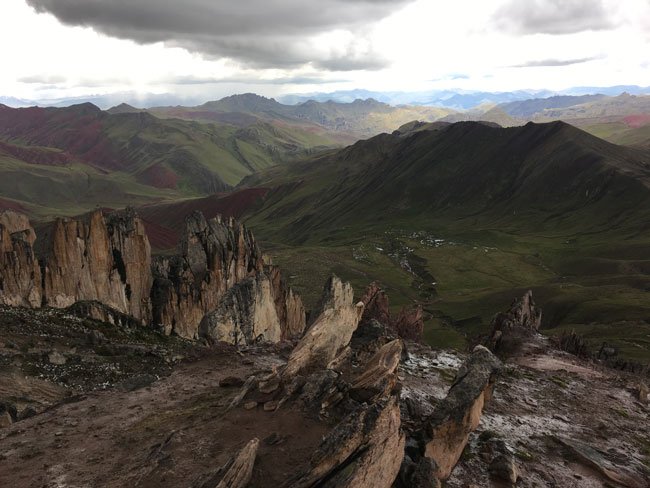
By Jake Fahey,
This week, as we honor the life of Martin Luther King, Jr. and the Civil Rights Movement he stands behind, I ask myself, what would he say in response to recent events? To this past year 2020? To the next wave of reeling forces of white supremacy that have leapt into the light?
In MLK’s letter written in Birmingham jail, he asserts that “we who engage in nonviolent direct action are not the creators of tension. We merely bring to the surface the hidden tension that is already alive. We bring it out in the open, where it can be seen and dealt with. Like a boil that can never be cured so long as it is covered up but must be opened with all its ugliness to the natural medicines of air and light, injustice must be exposed, with all the tension its exposure creates, to the light of human conscience and the air of national opinion before it can be cured.”
An enormous multi-racial movement led by people of color, Black Lives Matter and beyond, continuing in the footsteps of MLK, are helping us create a more liberated world, and the ugliness we see is the darkness rearing its ugly head against the blinding light.
Resmaa Menakem, author of My Grandmother’s Hands: Racialized Trauma and the Pathway to Mending Our Hearts and Bodies, says that “activism is not just about what we do; it is also about who we are and how we show up in the world. It is about learning and expressing regard, compassion, and love—for ourselves and for our fellow human beings.”
Listening to the words of MLK and Resmaa have helped me find my place in the movement. Working with other members of the Abbey of Hope Leadership Circle, we have read Resmaa’s book and engaged in the understanding that “White-body supremacy doesn’t live just in our thinking brains. It lives and breathes in our bodies.” Through monthly meetings, daily individual practice, and reflection, we have taken a step on the journey of building anti-racist practice into our day-to-day lives, and into the fabric of our organization itself. And there is so much more to do to confront the oppressor within.
MLK reminds us that “the plant of freedom has grown only a bud and not yet a flower.” There is so much work to do. But the soul of this land is in our hands. I have a choice. I can work to shift the generations of trauma in my body moment by moment, and envision a new culture, a new world, devoid of white-body supremacy.
I believe in the power that MLK and so many others fighting for a just world believe in, “a creative force in this universe working to pull down the gigantic mountains of evil, a power that is able to make a way out of no way and transform dark yesterdays into bright tomorrows.” And it will require each of us to take part. Jake Fahey is an interfaith chaplain and organizer living in Portland, ME in traditional Abenaki/Wabanaki territory. He is chair of the Social Action Committee for the Abbey of Hope.
Jake Fahey is an interfaith chaplain and organizer living in Portland, ME in traditional Abenaki/Wabanaki territory. He is chair of the Social Action Committee for the Abbey of Hope.
He has dedicated his life to the discovery of Truth inside and outside himself. He is humbled by his shortcomings, but continues to work to fulfill what Spirit has in store for him. He will fight for the collective liberation of all. He works in collaboration with the Chaplaincy Institute of Maine, the Abbey of Hope, and the Racial Equity Institute.
Photograph of Bosque de Piedras - Polccoyo, Andes Mountains, Peru by Jake Fahey
The Wisdom of Childhood for Living Our Beliefs
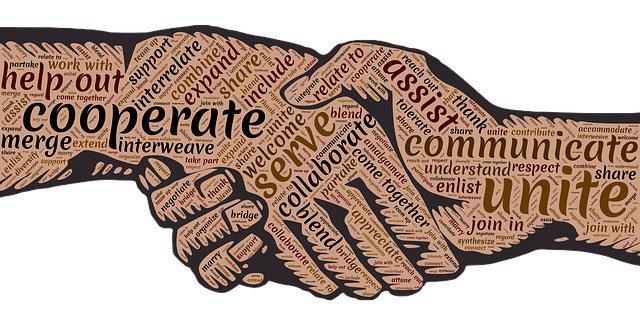
By Dr. L. Carol Scott,
How much closer to Spirit, God, Goddess (or whatever you call the holiest of holies), how much closer to divine guidance would we live, if we treated each person in our lives as divine in origin? If we truly know that we are each created, blessed, and loved by the divine, then what are the implications for our interactions with each other?
We’d get along beautifully with everybody, right? ALL our relationships at home, at work, and in the community at large, would overflow with trust, healthy interdependence, joyful play, and mutual respect and satisfaction, right? Wouldn’t every interaction with others be graced by acceptance of who they are?
You may be surprised to learn that every human capacity you have for those kinds of relationships was shaped in you before age seven. Not everything we need to know was learned in kindergarten, as Robert Fulghum’s book promised. Much of it we learned years before that schoolhouse door. And that is why most of us struggle with treating others as divine beings.
When our treatment of others fails to align with our spiritual principles, our human ego is telling us lies about ourselves and our loved ones. Sadly, most of those lies were first told during those early years. When each of us was born, we were beautifully and perfectly programmed to learn how to trust people and get along with them. And then life messed with our programming.
We are each born with this wisdom of childhood to ensure healthy relationships, in the form of 7 Childhood Treasures that enable us to express our spiritual beliefs interpersonally. Whether we seek to recognize our unity in a divinely interdependent web of all existence or seek to follow the Ten Commandments is irrelevant. Honoring others, whom we recognize as created by and embodying a divine power, treating them with respect as we interact with them, remains central to living those beliefs.
Good news! It is never too late to re-construct “how relationships go.” Early influences need not sentence us to a lifetime of painful or stressful relationships if we’ll do our work. The capacity for trust, damaged in our first six months, can be healed. We can learn to respect differences now if we didn’t at age two. Development Do-overs, in fact, are easier than the original. If you want to be closer to your concept of the divine, I recommend happier, more satisfying relationships as a critical pathway.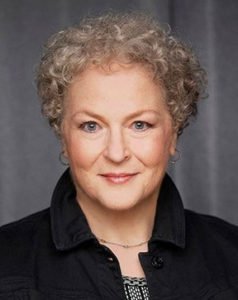 Dr. Carol Scott’s career focuses on early childhood development and its long-term impact on adults. For more than four decades, she has worked directly with thousands of children and adults, as she also walks a road to recovery from a childhood of abuse and trauma. Her master’s degree in early education and PhD in developmental psychology gave her the knowledge, and her life gave her the mission: to change the way we treat each other in America. www.lcarolscott.com
Dr. Carol Scott’s career focuses on early childhood development and its long-term impact on adults. For more than four decades, she has worked directly with thousands of children and adults, as she also walks a road to recovery from a childhood of abuse and trauma. Her master’s degree in early education and PhD in developmental psychology gave her the knowledge, and her life gave her the mission: to change the way we treat each other in America. www.lcarolscott.com
Clasped Hands image by John Hain
Peace on Earth
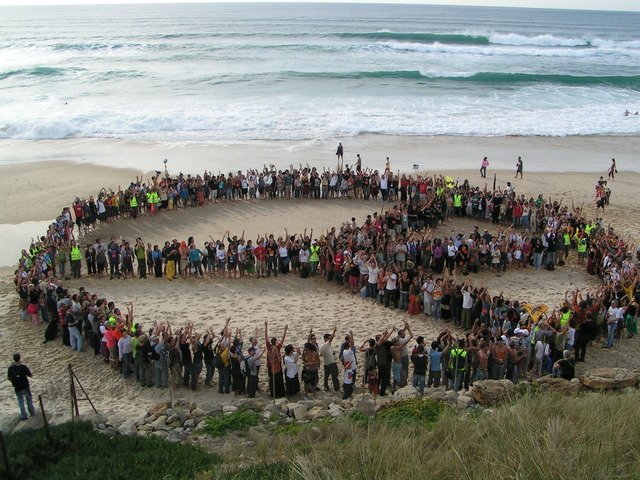
By Mary Gelfand,
Let Peace begin with me, let this be the moment now.With every step I take, let this be my solemn vow.To take each moment and live each moment in Peace eternally.Let there be Peace on Earth, and let it begin with me."
—Lyrics: Jill Jackson
When I was a child, growing up in the Methodist Church, “Peace on Earth” was my favorite part of the Christmas message. I loved singing “Let There be Peace on Earth,” a song that still brings tears to my eyes. I hold to this day a vivid image of angels bending down to earth to share this sacred message.
I grew up in central Florida in the 1950s & 60s—a child of the Cold War—trained to hide under my desk to save myself from nuclear annihilation. I was 12 during the Cuban Missile Crisis and vividly remember how terrified my parents were. I knew in my heart that we would be among the first casualties of the nuclear war that then seemed inevitable. I lost high school and college friends in Vietnam and volunteered as a draft counselor during college. My boyfriend applied to graduate schools in Canada in case he had to leave the country in order to avoid the draft. As I look back, I lived a lot of my formative years in the shadow of war.
I cannot begin to comprehend the life experiences of the thousands of individuals and families currently fleeing violence, war, and religious and ethnic persecution unlike any we in this country have ever experienced. My heart bleeds for those who suffer so, when all they are seeking is the time and space to live their lives in Peace.
In my young adult years, I pretty much defined Peace as the absence of war. When I began exploring Earth-centered spirituality, my definition of Peace expanded to include care for and healing of Mother Earth. How could there be Peace among humans while we daily raped and exhausted this beloved planet and showed no respect for other sentient beings?
In the last few years, my definition of Peace has expanded again—this time to affirm my belief that violence of any kind is a breaking of the Peace. As violence has spread throughout our society, and civil discourse has gone underground, it becomes clear to me that Peace Making must begin here at home, in our relationships with our families, our communities, and Mother Earth. That is the only way forward for all humans and other sentient beings with which we share this planet.
Albert Einstein once said that “Peace cannot be kept by force. It can only be achieved by understanding.” As I prepare to welcome the New Year of 2021, Peace on Earth continues to resonate with me. I affirm my intention to deepen my understanding of all sentient beings with which I share this world. I affirm my intention to let Peace begin with me—to make a solemn vow to take each moment and live each moment in Peace eternally. For the sake of our children and grandchildren—for the sake of Mother Earth, will you make this vow with me? Rev. Dr. Mary Gelfand is an ordained Interfaith Minister, a gifted teacher, and Wiccan High Priestess. She teaches and writes on the topics of feminist spirituality, Tarot, and Earth-centered spiritual paths. She resides in Wells with her husband Mark, two cats, and a forest full of birds, chipmunks, and other mysteries of life. You can see more of her writings at weavingthestars.blogspot.com.
Rev. Dr. Mary Gelfand is an ordained Interfaith Minister, a gifted teacher, and Wiccan High Priestess. She teaches and writes on the topics of feminist spirituality, Tarot, and Earth-centered spiritual paths. She resides in Wells with her husband Mark, two cats, and a forest full of birds, chipmunks, and other mysteries of life. You can see more of her writings at weavingthestars.blogspot.com.
Beach photo by Elodie Seigneur
Into the Light
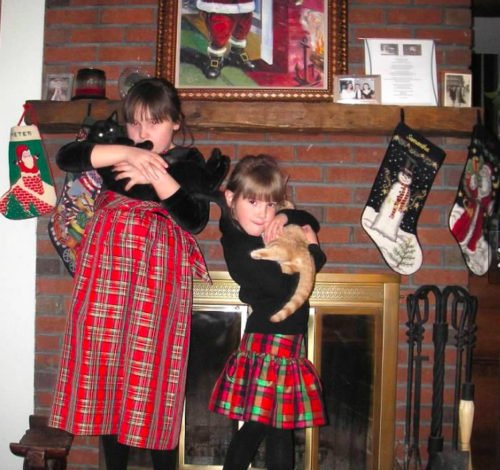
By Rev. Lori H. Whittemore,
The people who walked in darknesshave seen a great light;those who dwelt in a land of deep darkness,on them has light shone."—Isaiah 9:2
What a dark year 2020 has been. Much of the world became aware of the Coronavirus starting in January. By March and April the fullness of the health crisis started to become clear in the US as we experienced shut downs and watched horrific scenes of hospitals in NYC overrun with patients. And the rest of the year hasn’t improved. We walked in darkness this year.
Although my family was fortunate not to have experienced any close human loss of life, as have so many thousands in the pandemic, we did experience our own darkness. Over the course of 2020 we lost all of our family pets. Not only did these pets bring us joy and unconditional love, they symbolized my girl’s childhood years. A favorite picture is my young girls, probably around 6 and 9, dressed up in their Christmas dresses, each holding a cat. This year, as our animals began to fail, we were forced to think about their lives, our adventures together and let go. We had to face the end of an era.
As we entered the Advent season, I came across the passage from Isaiah that opens this reflection and pondered what light would and could lead me forward from personal loss and from the collective, lingering losses of 2020. I thought of a conversation I had with my eldest daughter. She said that she was tired of hearing how much people are “done” with 2020. She told me that this past year has really taught her to be grateful for what she has and what she has had. She is grateful for her job and the paycheck to pay her rent. Grateful that she is healthy and has access to healthcare. Grateful for the continued opportunity to work on her college education. Grateful for the years she had with Tom, Jerry, and Bailey.
Gratitude is the light leading me forward this year. As the Christian season of Advent culminates in the birth of the Son at Christmas, the flames of peace, hope, joy, and love have led me to this gratitude as well. Even with all of the darkness hanging on from the past year, the Light is shining brightly in our world. And in this time of pandemic, economic disparity, social unrest, and civic distress; I pray that the birth that is at the center of the Christian celebration will inspire hope, joy, peace, love, light—and deep gratitude! Lori Whittemore a spiritual care volunteer for the American Red Cross and Maine Behavioral Health, as well as the founder and director of Abbey of Hope and Clinical Pastoral Training Center of Southern Maine (CPTCSM). Through CPTCSM she trains chaplains and pastoral care givers with today’s varied religious and spiritual landscape in mind. Rev. Whittemore approaches interfaith ministry from her Christian background and training as well as her interfaith education at Chaplaincy Institute of Maine.
Lori Whittemore a spiritual care volunteer for the American Red Cross and Maine Behavioral Health, as well as the founder and director of Abbey of Hope and Clinical Pastoral Training Center of Southern Maine (CPTCSM). Through CPTCSM she trains chaplains and pastoral care givers with today’s varied religious and spiritual landscape in mind. Rev. Whittemore approaches interfaith ministry from her Christian background and training as well as her interfaith education at Chaplaincy Institute of Maine.
Girls with Cats picture by Lori H. Whittemore.
Bringing Back the Light
By Nikki Starcat Shields,
My family has been hosting Winter Solstice gatherings for more than 25 years. I’m not sure how the tradition began, but we keep our backyard Solstice bonfire burning all night long. Perhaps it’s because I’m a night owl, so greeting the sun at sunrise doesn’t sound appealing, unless I stay up! Whatever the origin, it has become our way of honoring the rebirth of the sun and helping to bring back the light.
Although winter is just beginning, the days start to grow longer again just after the Solstice. This has been a source of hope for people throughout history. As we hold the vigil all night, I like to think that we’re helping to encourage the sun to grow stronger, to shine just that much brighter.
We cast our circle at sunset, with the ritual lighting of the bonfire. One of the first things we did when we moved to this land, which once belonged to my grandmother, is to build a huge fire pit. The Winter Solstice fire is laid with care, topped with last year’s Yule tree. The audible “whoosh!” when it erupts into flames marks the start of the festivities.
After welcoming the elements and the Divine, and making some music, we usually share food and drink, and exchange gifts with friends. We keep the sacred circle open all night. Not everyone stays up, of course. Many of the attendees head home before midnight. But there are always the stalwart few who take turns tending the fire. We come and go, tromping the snowy, lantern-lit path from the cold wintry night to the warmth of our home. We listen to music, play board games, and switch from mead to coffee to help us stay awake.
Even with good company, this is the longest night of the year. It’s not an easy vigil. I remember the first time my children managed to stay awake the whole night—they were so proud! My son, who was 9, had a tearful meltdown upon discovering that he still had to go to bed, just at a different time of day. Now they are both grown, and my daughter will be keeping the vigil with us this year after moving back home from out west.
When the very first hints of light finally start showing above the trees, it’s a revelation! There is such magick in that hint of golden yellow, which expands to a glowing orb. At full sunrise, we release the circle, thanking all the beings who held our vigil with us. Just a few revelers remain standing. Sometimes there are pancakes to be shared afterwards. Other times, we’re ready to rest as soon as the fire is safely out.
This pandemic year will be different, as it’s just our immediate family who will be celebrating. But the fire will be kept, the tradition goes on, and a couple of us will still stumble to bed after the sun comes up, exhausted and happy. The sun will return. Nikki Starcat Shields is an author, book midwife, and leader of transformational writing retreats. She's also a licensed Pagan priestess. Nikki teaches people to be Thriving Artists, writing their heartfelt books while also nurturing themselves and their creative lives. She lives in Hollis, Maine and adores reading, cats, and spending time by the ocean. She can be found at http://www.nikkistarcatshields.com
Nikki Starcat Shields is an author, book midwife, and leader of transformational writing retreats. She's also a licensed Pagan priestess. Nikki teaches people to be Thriving Artists, writing their heartfelt books while also nurturing themselves and their creative lives. She lives in Hollis, Maine and adores reading, cats, and spending time by the ocean. She can be found at http://www.nikkistarcatshields.com
Winter Solstice Path photo by G.E. Nelson Photography
Rededicating Our Temples
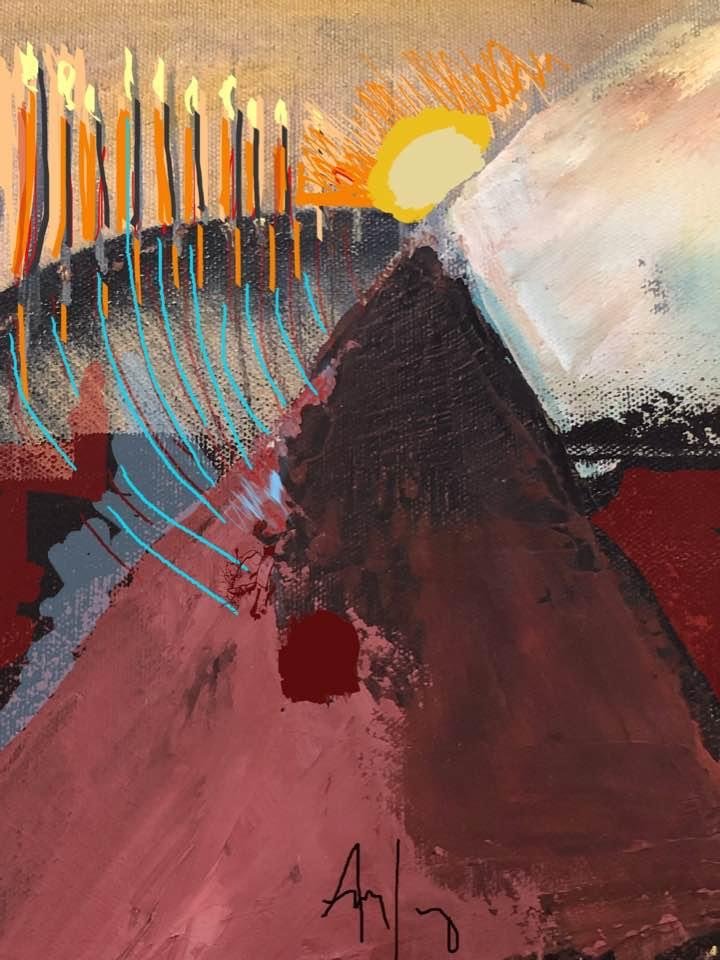
By Joyce Zonana,
It’s the simplest of rituals, the most basic, the most easily taught and passed down: During the dark of winter, on one of the longest nights of the year, we light a candle. Then we use that candle to light another, placing each in a candelabra. The next night, we light an initial candle again—called the shamash, or helper, in Hebrew—then use it to light two more. Now we have three candles burning. The night after that, we light three candles with the shamash. And so on, night after night, for a total of eight nights, until our candelabra—known as a menorah—holds a total of nine candles.
The menorah I’ve used for more than forty years, carrying it with me from place to place, was a gift from a friend, the daughter, it was said, of a Nazi. She’d noticed me admiring it in a neighborhood shop window, and surprised me with it one December morning. I’ve treasured that menorah, with its brass candle-holders shaped like a rollicking klezmer band, cherishing it as a symbol of reconciliation. In recent years, I would bring it along to Chicago, where my husband and I regularly celebrate Christmas with his family. During Chanukah, I would faithfully light the candles, inviting my in-laws to join in. Although we won’t be traveling this season, we will observe Chanukah all the same.
As we light our candles, we sing songs of praise, hymns lauding the magnificence and beneficence of the Divine (psalms 113-118, known as the Hallel, as in hallelujah, “praise be to our God.”)
The light from our candles increases each night, but we use their shimmering glow not to illumine our homes but to brighten our souls. We take time apart from our ordinary activities to watch the candles burn, marveling in their splendor, celebrating the re-emergence of light in darkness. If we have children, we tell tales of the miracle commemorated by our ritual—consecrated oil that should have lasted only one night lasted eight, allowing our ancestors to rededicate their temple after a bitter battle.
Of course there is another miracle that occurs at just around the same time, every year: the return of the sun that had been seeming to disappear into darkness. I see it as entirely fitting that the word for our initial candle, shamash, is also the Babylonian word for the Sun God, dispenser of divine justice.
Chanukah commemorates the rededication of our temple. And isn’t that what all rituals invite us to do? Return to the source, remember our origins, reclaim our divine heritage. Mircea Eliade tells us that ritual brings us into sacred time and sacred space, the time and space of eternity, the time and space of our true home. When I light my Chanukah candles every year, I rededicate my temple, re-entering sacred time and space. I invite you to join me. Joyce Zonana is a regular contributor to the blog, Feminism and Religion. A writer and literary translator, she is the author of a memoir, Dream Homes: From Cairo to Katrina, an Exile’s Journey. Her most recent translation is Tobie Nathan’s A Land Like You.
Joyce Zonana is a regular contributor to the blog, Feminism and Religion. A writer and literary translator, she is the author of a memoir, Dream Homes: From Cairo to Katrina, an Exile’s Journey. Her most recent translation is Tobie Nathan’s A Land Like You.
“Sunrise Menorah,” Digital image, 2020. Reprinted by permission of the artist, Deborah Saltz Amerling.
Another Jewish Holiday in a Pandemic
By Andrea Levinsky,
Right now, many Christians are gearing up toward their holiest days during the time of COVID-19, and wondering what that will be like. As Jews we have already celebrated our most important and holy days in the fall. Rosh Hashannah and Yom Kippur were of course different this year, but still meaningful as there were multitudes of online services from all over the world available, care packages from the Temple with needed items, and connecting of friends and relatives (even those who live in far-flung places) over the internet. There were definitely some benefits of worshiping in this way! I was able to bring my computer outside and attend services in the sunshine. I could control the temperature when I was indoors to exactly what I wanted. I could eat a snack or go to the bathroom whenever I wanted. Of course, I look forward to going back to when we can gather again, but I assure you that you can still have a meaningful holiday!
The more minor Jewish holiday of Chanukkah began this week and there are many creative ways to celebrate during the pandemic. Outdoor menorah lightings and holiday care packages abound, in addition to online versions of playing dreidel. My family plans to gather on Zoom to light candles together virtually. We will still be giving my grandparents their annual gift of a calendar with photos of their grandchildren and great grandchildren on each page. Normally, we would be together eating latkes and doughnuts, lighting our menorahs, and having a family Yankee Swap. We would line the table with tin foil and fill it with as many menorahs as it could handle. We would sing the blessings together and bask in the light and warmth of the candles.
It might feel scary to think of how we will be celebrating all our holidays, no matter our faith, during the time of COVID-19. But we can do it! We will get through this different year and hopefully appreciate all our holiday traditions even more in the years to come.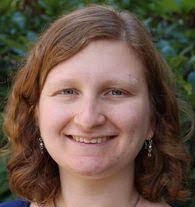 Andrea Levinsky has been an educator both in traditional schools and in supplemental education programs. She holds a B.A. from Connecticut College where she studied American Studies, Human Development, Education, and Public Policy. She is currently the Extended Learning Opportunities Coordinator at Portland High School. She loves building Jewish Community and is active with both Jewish Action Maine and Moishe House. She is passionate about interfaith connections and is very excited to do this through the Abbey! She also enjoys dance and participating in musical theater productions.
Andrea Levinsky has been an educator both in traditional schools and in supplemental education programs. She holds a B.A. from Connecticut College where she studied American Studies, Human Development, Education, and Public Policy. She is currently the Extended Learning Opportunities Coordinator at Portland High School. She loves building Jewish Community and is active with both Jewish Action Maine and Moishe House. She is passionate about interfaith connections and is very excited to do this through the Abbey! She also enjoys dance and participating in musical theater productions.
Dreidel photo by Robert Zunikoff
My Life Mattered
By Helen G. Rousseau,
I know what it’s liketo feel your life doesn’t matter.So long ago, but I remember.Warts on handsI hid under the deskwhen the nun came by.
A friend’s mother,looking at my dirty kid self,assessing if she wantsher daughter to play withthis scruffy girlwho knows that look.
Roller skating with a friendwho comments on the bugscrawling on my neck.I run home to whereanother round of foul-smellingliquid gets poured on my hair.
Neglect was what I knewas a child. Teeth covered with tartar,my hand would hide my smile.For years, my outward appearancehumbled me. I feared someonewould discover the truth.
However,
I never, ever, was pulledover because I was white.My car was never searchedfor drugs. My home neverbroken into, a gunpointed at my head.
I have received kindnessand deference because I was a nun.Officers have smiled, given mewarnings because of my white hair.My skin color never put fearinto a shop clerk.
My presence never madeanyone step aside,wondering if I would hurt them.Though I wasn’t aware of it,I walked with white privilege,expecting proper behaviortoward me at all times.
I have prided myselfin not taking life for granted,always grateful for what I have.I never realized, until now,the protections that mywhite skin provides me.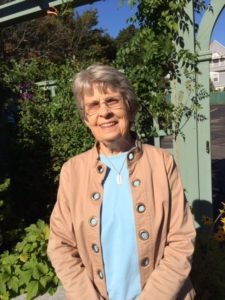 Helen is an ordained Interfaith Minister. She was a Catholic nun for thirty years and spirituality has always been central to her life. At present, she sees her ministry as writing and leading writing groups, which she has done for twelve years.
Helen is an ordained Interfaith Minister. She was a Catholic nun for thirty years and spirituality has always been central to her life. At present, she sees her ministry as writing and leading writing groups, which she has done for twelve years.
Her latest book of poetry is entitled Poems for a World on Fire: Meditations on Hope, from which this poem was taken. Its focus is on all the major issues of our day including global warming, migrations, and COVID-19. These poems give voice to the earth, its peoples, animals, trees, seas, land, and all that makes this planet uniquely our home. Her work is infused with an underpinning of hope and a trust in life. She reads a poem every week on Facebook. To contact Helen or order a book, go to www.helenrousseau.com
Poems for a World on Fire cover illustration and design by Lindy Gifford.
Happy New Year!
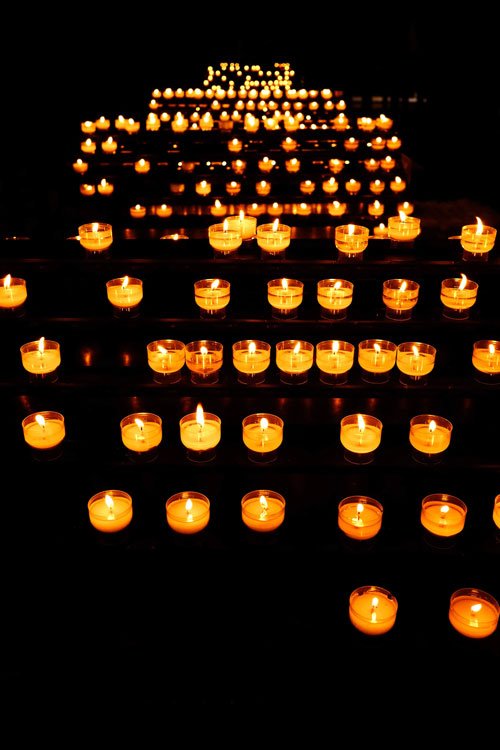
By Christopher Fuller,
While the world celebrates the new year each year on January 1, many religious and cultural traditions have their own unique new year celebrations at different points throughout the year. Judaism observes Rosh HaShanah, Muslims celebrate Ra’s as-Sanah al-Hijrīyah, and, of course, many of us are familiar with Chinese New Year. In the same way, Advent marks the beginning of the religious new year for many Christian denominations. (This year, Advent begins today, November 29.) Derived from the Latin word adventus which means “arrival,” it is the liturgical period during which Christians prepare for the birth of Jesus. However, as important as this event is, it is what his coming means that is as significant. To appreciate this deeper meaning, it is helpful to turn to first-century Jewish expectations.
By the time of Jesus, the worldview of most Jews was shaped by their scriptures (what Christians now call the Old Testament), principally a story of how disobedience had introduced sin into the human experience disrupting relationships with one another, with God, and with creation (Genesis 3:12-24) and how God had set out to reclaim the world by restoring order to all of these relationships (Isaiah 65:17). By its faithfulness to the covenant, principally through love of God and love of neighbor, Israel would model for the rest of the nations the wisdom of God’s plan for the world (Deuteronomy 4:5-8). In particular, the covenantal neighborliness of Israel’s life together would manifest itself as justice for the poor (Exodus 22;21-24). In this way it would be a “light unto all nations” (Isaiah 42:6). Unfortunately, like Adam and Eve, Israel believed that it had also fallen prey to disobedience and that God had cast it from its land into exile (Lamentations 1). However, there remained the assurance that God would fulfill the divine promise to put the world to rights and restore a just ordering of relationships.
For Christians the birth of Jesus is how God inaugurates this divine plan. Thus, echoing the call of Israel, Jesus teaches his followers to let their light shine before others (Matthew 5:16). He also instructs them to feed the hungry, give drink to the thirsty, welcome the stranger, clothe the naked, tend to the sick, and visit those who are imprisoned (Matthew 25:31-46). When they determined that Jesus’ resurrection was the “first fruits” (1 Corinthians 15:20) of God’s promised renewal, they concluded it was their task to break bread with one another, pray, share life together, and distribute their possessions to those in need as a witness to what God had set in motion through Jesus (Acts 2:44-45).
Each year we wait for the arrival of January 1, and we approach it as an opportunity for renewal. For Christians, in addition to anticipating the birth of Jesus, the Advent season serves as a reminder of the renewal that God set in motion in him and our responsibilities to live lives that bear witness to that conviction.
Votive photograph by Christopher Fuller
 Christopher Fuller is the Vice President & Chief Sponsorship and Mission Integration Officer at Saint Joseph's College. Dr. Fuller has worked for twenty-five years in Catholic higher education. Prior to his position at Saint Joseph's, he was an associate professor of theology and Director of the Hunthausen Center for Peace and Justice at Carroll College in Helena, Montana. He also served as a campus minister for ten years at Saint Mary’s College of California. During his career, Dr. Fuller has worked collaboratively with people from a variety of faith backgrounds, both Christian and non-Christian. Dr. Fuller earned his bachelor’s degree in communications at UCLA, and his master’s degree in biblical studies and doctorate in interdisciplinary studies at the Graduate Theological Union in Berkeley, California. Chris and his wife, Martha, reside in Portland, Maine and have raised identical twin sons together.
Christopher Fuller is the Vice President & Chief Sponsorship and Mission Integration Officer at Saint Joseph's College. Dr. Fuller has worked for twenty-five years in Catholic higher education. Prior to his position at Saint Joseph's, he was an associate professor of theology and Director of the Hunthausen Center for Peace and Justice at Carroll College in Helena, Montana. He also served as a campus minister for ten years at Saint Mary’s College of California. During his career, Dr. Fuller has worked collaboratively with people from a variety of faith backgrounds, both Christian and non-Christian. Dr. Fuller earned his bachelor’s degree in communications at UCLA, and his master’s degree in biblical studies and doctorate in interdisciplinary studies at the Graduate Theological Union in Berkeley, California. Chris and his wife, Martha, reside in Portland, Maine and have raised identical twin sons together.
Thanksgiving

By gkisedtanamoogk,
Thanksgiving is once again upon us. While we are challenged this year, may we continue our view of Thanksgiving as embodying Family, Society, and Country. There is however, another view, the view from the shore, a view of history and life prior to, and since, the arrival of the Separatist English in November 1620. The Separatists, or ‘Pilgrims’, came to the shores of the Wampanoag, my People and Culture. For the Wampanoag, celebrating an annual multitude of Thanksgivings is a time honored tradition dating since time immemorial. Historic accounts of autumn 1621 vary, from intentional invitation, to one of the uninvited, surprise, suspicion. What came here to the Wampanoag in the 17th century were purposeful alternatives to Indigenous Life and living, alternatives of European values reliant on 15th century Papal Bulls. In November, 1970, by Frank James and other Wampanoag, Thanksgiving became a National Day of Mourning, mourning how life since the 17th century has not been so great for the Wampanoag and generally, for Indigenous Peoples throughout the Americas. Living with histories of devastation since King Philp’s War (1675-1678) and before then, in the Great Dying (1617-1619) is quite challenging. Wampanoag vindication envisions the Path for Humanity based once again upon the relationship to Earth and Sky. In words of the late Frank James: “Now, [400] years later, you…are celebrating an anniversary the Wampanoag will help you celebrate in the concept of a beginning…a beginning of a new determination for the original American: the American Indian.” gkisedtanamoogk, is from the Wampanoag Community of Mashpee located on cape cod south of boston, massachusetts, married to Miigam’agan. Together they have three Children and three Grandchildren. He was one of five Commissioners on the Maine Wabanaki State Child Welfare Truth and Reconciliation Commission and taught for 10 years at the University of Maine. He has shared several presentations with the Chaplaincy Institute of Maine. gkisedtanamoogk resides with his Family at Esgenoôpetitj on the Burnt Church Reserve; he would say that Mi’kmaq Homelands are occupied by the province of new brunswick and canada.
gkisedtanamoogk, is from the Wampanoag Community of Mashpee located on cape cod south of boston, massachusetts, married to Miigam’agan. Together they have three Children and three Grandchildren. He was one of five Commissioners on the Maine Wabanaki State Child Welfare Truth and Reconciliation Commission and taught for 10 years at the University of Maine. He has shared several presentations with the Chaplaincy Institute of Maine. gkisedtanamoogk resides with his Family at Esgenoôpetitj on the Burnt Church Reserve; he would say that Mi’kmaq Homelands are occupied by the province of new brunswick and canada.
“The First Thanksgiving, 1621” by Karen Rinaldo
A Passover of the Heart
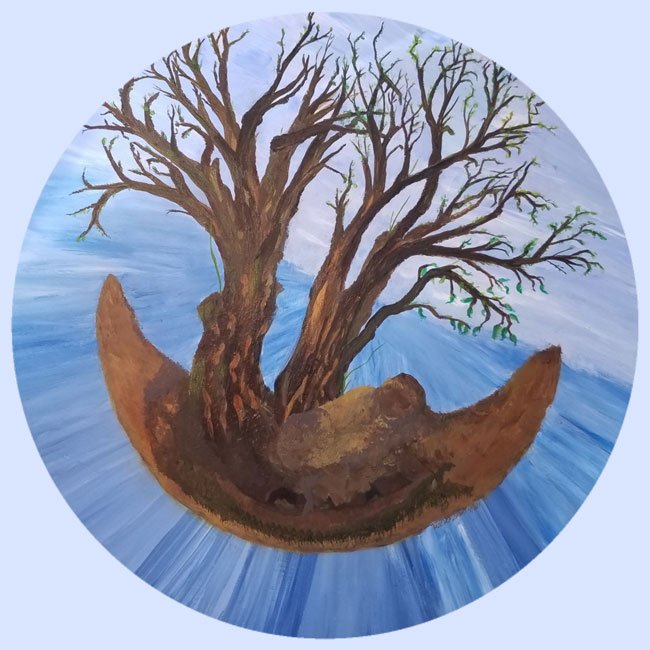
By James A. Weathersby,
A change is coming. A change so epic in scale that people will never be the same again. People resist change, because change is uncomfortable and disturbing. Change requires adjustment and letting go of what once was, in order to make room for something unexpected. Change does not listen to our protestations or our old ways of doing things; we must accommodate, we must improvise, we must adapt, and we will survive. Change threatens our existence, because it challenges the status quo. A powerful Elephant grows accustomed to its chain; it will walk in circles without it! That magnificently strong pachyderm must be retaught freedom. I remember Gandhi praying for the emerging India: “We but mirror the world. All the tendencies present in the outer world are to be found in the world of our body. If we could change ourselves, the tendencies in the world would also change. As a man changes his own nature, so does the attitude of the world change towards him America must change; we must change how we see others and we must change how we see ourselves”. Scriptures call that self-examination process ’rebirth’. America must be born again.
We find remembered in the Bible, these words of the Old Testament Book of Exodus, chapter 12, “This day shall be a day of remembrance for you. You shall celebrate it as a festival to the LORD; throughout your generations you shall observe it as a perpetual ordinance.” (Vs.14) This is the chapter commemorating the institution of Passover, when God liberates the children of Israel from their Egyptian Captivity. The Children of Israel had been in slavery for over 400 years. Their patriarch Joseph dies, and a new Pharaoh takes the throne, who does not remember the history of Joseph. The people are enslaved, their tasks are harsh, and they cry out to God for deliverance (2:23-25). Moses is that deliverer, bigger than life. However, Moses must be called and formed into that deliverer (Chapter 3).
God never forgets the divine plan for Moses. Plagues descend on Egypt as judgment, culminating in the death on the first—Born of Egypt. The Jewish homes have lambs’ blood on their doorposts. Death passes over them, instituting the Celebration of Passover. Death passes over those Jewish homes with blood on the doorposts. They are liberated! Change is here: change of heart, change of location, change of perspective. What has this to do with today? A Passover of our heart is here!
America is undergoing a painful, uncomfortable change. Change of mindset about who is an American. Change in perspective about justice and mercy for the peoples. Change in heart, because we all are vulnerable to Corona Virus and the virus of Racism. This is broad reaching, but necessary. If America is no longer the same, we the people changed it. If America is to become better than now, we shall change that. The Passover of the heart is change; God lives among us still and we can remember how to live together. God help us all, we are all in need of liberation. Pax The Rev. James A. Weathersby M.Div., BCC was born in Chicago, product of a dedicated single mother and the Public-School system. He is a genetic Baptist and a historic Democrat; spirituality in his veins for generations. His family valued Education and the Black church; there are four generations of ministers in his family, serving as Pastors of congregations and Chaplains in Institutions. His Bachelors of Arts came from Trinity Christian College in Palos Heights, Illinois from the Reformed Churches of America tradition. His Masters of Divinity Degree (specialty in Pastoral Care and Counseling) came from the Southern Baptist Theological Seminary of Louisville Kentucky, from the Southern Baptist tradition. His professional career as a Chaplain includes serving populations in Hospitals, Hospice, both Men’s and Women’s Corrections (Death Row Chaplain) in several Midwestern states. His time in Maine has included Chaplaincy at a Youth Development Center, Pastor to an island congregation and lately, Chaplain (II) of the State Forensic and civil Psychiatric Center. He has been honored to be married for 27 years and enjoy writing, yoga, and reading.
The Rev. James A. Weathersby M.Div., BCC was born in Chicago, product of a dedicated single mother and the Public-School system. He is a genetic Baptist and a historic Democrat; spirituality in his veins for generations. His family valued Education and the Black church; there are four generations of ministers in his family, serving as Pastors of congregations and Chaplains in Institutions. His Bachelors of Arts came from Trinity Christian College in Palos Heights, Illinois from the Reformed Churches of America tradition. His Masters of Divinity Degree (specialty in Pastoral Care and Counseling) came from the Southern Baptist Theological Seminary of Louisville Kentucky, from the Southern Baptist tradition. His professional career as a Chaplain includes serving populations in Hospitals, Hospice, both Men’s and Women’s Corrections (Death Row Chaplain) in several Midwestern states. His time in Maine has included Chaplaincy at a Youth Development Center, Pastor to an island congregation and lately, Chaplain (II) of the State Forensic and civil Psychiatric Center. He has been honored to be married for 27 years and enjoy writing, yoga, and reading.
A New Birth, painting by Valerie A. Clemons.
Manifesting a Vision During the Pandemic
By Robert Atkinson,
One Planet Peace Forum was a vision long before this challenging year. When I was living in the Seacoast area in the mid-1970s, I became very familiar with the beauty, spirit, history, and community of Green Acre, in Eliot, Maine.
I was inspired by the vision of Sarah Farmer, its founder, who had attended the first Parliament of the World’s Religions in Chicago in 1893. She invited Vivekananda, Dharmapala, and many others, including New England Transcendentalists, to speak on the universal platform she had created at Green Acre, where she also raised the first known peace flag in 1894.
Since then, I’ve held the vision of offering similar interfaith, interdisciplinary gatherings at Green Acre, a very active Baha’i Center of Learning, that would be open to all to explore solutions to the most challenging issues facing humanity today, during an off week of its year-round programs.
In 2014, Dana Sawyer introduced me to Lori Whittemore who was envisioning the Abbey of Hope; he thought our visions might overlap. I became an inaugural board member of the Abbey, an interfaith Cooperation Circle of United Religions Initiative. In March 2019, URI announced a funding opportunity for a regional gathering of peacebuilders to collaborate, co-create, and engage the head and heart to further social justice and diversity work.
We applied, received the grant from URI, and began our planning in May 2019. A full weekend program of amazing presenters was soon in place, through regular monthly meetings of the fully dedicated volunteer planning team.
Then in March 2020, when the pandemic hit, just like so many others, we had to figure out whether to cancel, reschedule, or come up with a totally different plan. After a few weeks in limbo, and with URI’s assurance that we could reschedule to 2021, we began to consider shifting to a virtual event.
Amazingly, all but a couple presenters recommitted to 2021 and offered to present at a much condensed 3-day virtual Forum during that original weekend. We partnered with Good of the Whole, a URI Cooperation Circle, to co-produce the virtual program on their platform. With a few adjustments along the way, all went very smoothly.
Our inaugural virtual Peace Forum is behind us, but there is still a long way to go to realize the age-old vision of peace on earth. Beginning with a holistic vision to peace making, we approach peace as an ongoing inner and outer process, as well as the outcome of a long evolutionary trajectory, with built-in cycles of ups and downs.
This process is taking us to new levels of advancement toward nuclear disarmament, civil rights, human rights, gender equality, environmental, economic, social, racial, and restorative justice, all interconnected stepping-stones to peace, which have all reached a critical tipping point in this tumultuous year. We invite you to join the ongoing conversation on our Facebook page, visit our website, and attend next year’s One Planet Peace Forum.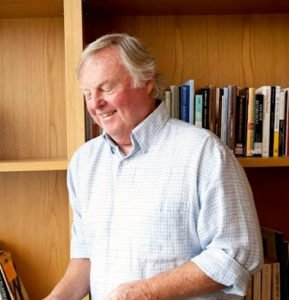 Robert Atkinson, PhD, author, educator, and developmental psychologist, is a 2017 Nautilus Book Award winner for The Story of Our Time: From Duality to Interconnectedness to Oneness. He is also the author or co-editor of eight other books, including Our Moment of Choice: Evolutionary Visions and Hope for the Future (2020), Year of Living Deeply: A Memoir of 1969 (2019), Mystic Journey: Getting to the Heart of Your Soul’s Story (2012), and The Gift of Stories (1995). He is professor emeritus at the University of Southern Maine, founder of One Planet Peace Forum, a member of the Evolutionary Leaders, and deeply committed to assisting the evolution of consciousness toward wholeness and unity. www.robertatkinson.net
Robert Atkinson, PhD, author, educator, and developmental psychologist, is a 2017 Nautilus Book Award winner for The Story of Our Time: From Duality to Interconnectedness to Oneness. He is also the author or co-editor of eight other books, including Our Moment of Choice: Evolutionary Visions and Hope for the Future (2020), Year of Living Deeply: A Memoir of 1969 (2019), Mystic Journey: Getting to the Heart of Your Soul’s Story (2012), and The Gift of Stories (1995). He is professor emeritus at the University of Southern Maine, founder of One Planet Peace Forum, a member of the Evolutionary Leaders, and deeply committed to assisting the evolution of consciousness toward wholeness and unity. www.robertatkinson.net

